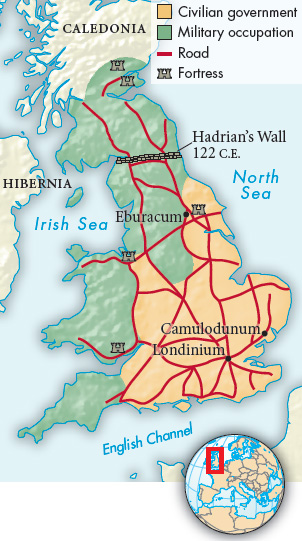A History of Western Society: Printed Page 167
A History of Western Society, Value Edition: Printed Page 169
The Age of the “Five Good Emperors”
The Flavians were succeeded by a line of relatively competent emperors, whom the political philosopher Niccolò Machiavelli in the sixteenth century termed the “five good emperors” — Nerva, Trajan, Hadrian, Antoninus Pius, and Marcus Aurelius. Machiavelli praised them because they all adopted able men as their successors during their lifetimes instead of relying on birth to provide an heir, thus giving Rome stability. None except Marcus Aurelius had a legitimate son, however, so they actually had little choice. They were also following the pattern set by Julius Caesar and Augustus, not breaking new ground. The last four “good emperors” were, in fact, related members of the Antonine family. Historians since Machiavelli have also noted that in some cases their choices were the result of pressure by the army or members of their family, rather than their own political astuteness. Whatever the reasons for the pattern, however, because all of these emperors were experienced generals and members of the Senate, Rome was provided with a stable series of well-trained political and military leaders for nearly a century, from 96 C.E. to 180 C.E.
Augustus had claimed that his influence arose from the collection of offices the Senate had bestowed on him and that he was merely the first citizen. Already during his rule many recognized that this was a façade, but the Senate continued to exist as a deliberative body and Rome remained officially a republic. Gradually the rulers expanded their individual powers, however, and Rome became in fact an empire, in which increasing amounts of power were held by one man. Although they never adopted the title “king” — this would have been seen as too great a break with Roman traditions — the rulers of Rome are conventionally called emperors. And as emperors took on new tasks and functions, their influence was felt in more areas of life and government.
Hadrian is typical of the emperors of the second century. He received a solid education in Rome and became an ardent admirer of Greek culture. He caught the attention of his elder cousin Trajan, the future emperor, who started him on a military career. At age nineteen Hadrian served on the Danube frontier, where he learned the details of how the Roman army lived and fought and saw for himself the problems of defending the frontiers. When Trajan became emperor in 98 C.E., Hadrian was given important positions in which he learned how to defend and run the empire. Although Trajan did not officially declare Hadrian his successor, at Trajan’s death in 117 Hadrian assumed power.
Hadrian built a number of buildings, including the circular Pantheon in Rome and new temples in Athens. He established more formal imperial administrative departments and separated civil service from military service. Men with little talent or taste for the army could instead serve the state as administrators. These innovations made for more efficient running of the empire and increased the authority of the emperor.

Under Trajan the boundaries of the Roman Empire were expanded to their farthest extent, and Hadrian worked to maintain most of these holdings, although he pulled back Roman armies from areas in the East he considered indefensible. No longer a conquering force, the army was expected to defend what had already been won. Forts and watch stations guarded the borders. Outside the forts the Romans built a system of roads that allowed the forts to be quickly supplied and reinforced in times of rebellion or unrest. Trouble for the Romans included two major revolts by Jews in the eastern part of the empire, which resulted in heavy losses on both sides and the exile of many Jews from Judaea.
Roman soldiers also built walls, of which the most famous was one across northern England built primarily during Hadrian’s reign. Hadrian’s Wall, as it became known, protected Romans from attacks from the north, and also allowed them to regulate immigration and trade through the many gates along the wall. Like all walls around cities or across territory, it served as a symbol and means of power and control as well as a defensive strategy. The later emperor Antoninus Pius built a second wall one hundred miles north, but this was quickly abandoned. Thousands of troops patrolled Hadrian’s Wall until the Romans pulled out of the area in the late fourth century.
As the empire expanded, the army grew larger, and more and more troops were auxiliary forces of noncitizens. Because army service could lead to citizenship, men from the provinces and even from beyond the borders of the Roman Empire joined the army willingly to gain this, receive a salary, and learn a trade. (See “Individuals in Society: Bithus, a Soldier in the Roman Army.”) The army evolved into a garrison force, with troops guarding specific areas for long periods. Soldiers on active duty had originally been prohibited from marrying, but this restriction was increasingly ignored, and some troops brought their wives and families along on their assignments.
“Five Good Emperors” (the Antonines)
| 96–98 | Nerva |
| 98–117 | Trajan |
| 117–138 | Hadrian |
| 138–161 | Antoninus Pius |
| 161–180 | Marcus Aurelius |